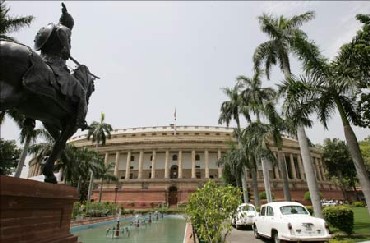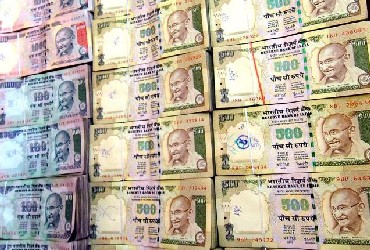
Two decades ago when the finance ministry discovered 'divestment' as a way of raising revenue from the sale of public sector equity to private entities, the Indian Left saw this as privatisation through the backdoor.
While India's politicians have had a love-hate, see-saw relationship with the idea of privatisation, divestment has continued as a favourite revenue raising measure of finance ministry mandarins.
The divestment process in the current financial year is set to kick off with the follow-on public offer (FPO) of Power Finance Corporation on May 10.
The government has fixed a target of generating Rs 40,000 crore (Rs 400 billion) through sale of stake in public sector undertakings (PSUs) this financial year.
...

How feasible is this target in the light of the government's performance on this count in the last two decades? Will the current mode of divestment yield the best results?
A look at evolution of the current divestment policy indicates that fiscal compulsions, rather than privatisation, have driven divestment, barring the time when Arun Shourie was the divestment minister during the NDA regime.
According to divestment secretary Sumit Bose, the Rs 40,000 crore (Rs 400 billion) for this year is less than 0.45 per cent of the gross domestic product (GDP). He pointed out at the recent annual conference of the Confederation of Indian Industry that the 13th finance commission estimated that divestment would yield Rs 3.81 lakh crore, or 0.88 per cent of GDP, over the five years to 2015.
"We are targeting half of it; it is extremely realistic," he said.
...

The current government policy is to list all profitable PSUs owned by the Union government. Those which do not meet the listing norms of 10 per cent need to be brought up to it. FPOs have to be floated to raise resources for the government.
It is also ok to piggyback companies when they raise resources for their capital expenditure.
The government will continue to hold at least 51 per cent equity and spend the money raised on inclusive growth.
Bose said divestment of PSUs had resulted in improved efficiency. However, those associated with the process earlier said the critical part in the whole process was taking control out of the government's hands.
"They can have a target, but I don't know how they are going to achieve it. The government does not have a clear policy," said G V Ramakrishna, chairman of the erstwhile divestment commission.
He said 5-10 per cent government holding could be unlocked if the government got good value for it.
...

"Autonomy is more important. The government should go for proactive divestment. Revamping and remodelling of PSUs should be at the base. Some white paper on divestment should be brought out by the government and then a clear-cut policy should be formulated," said Ramakrishna.
Pradip Baijal, who was divestment secretary when Shourie was the minister, said: "If we shift control, we get more value. However, it is a political decision and that has to be decided by the political class."
He pointed out that Hindustan Zinc, Maruti and Balco divestments prove how shifting of control unlocked value.
"After the shift of control, their share value, productivity and tax payments grew multi-fold. Compare this with Air India, which was not privatised. The results in the two cases speak for themselves. The present government has decided not to transfer control; it will get less money," said Baijal.
...

Bose said the government's focus was more on creating capital assets through six social sector programmes using the divestment money.
"One class of assets we are selling and another class of assets we are creating in rural and urban areas. It is a win-win situation for everybody," he said.
Left Front leader Sitaram Yechury, however, termed this an eyewash. "Not a single pie obtained from divestment is going into the social sector. The government is utilising the divestment money to meet the budgetary deficit."
He said the government should prepare a package for reviving PSUs rather that selling these.
"The Kerala experience is a case in point where PSUs have been revived and the resources coming out from them have been utilised for social sector schemes."
...

In the current financial year, the government plans to dilute its stake in eight state-run companies. The FPO route is expected to be taken in five cases and the IPO route in two. In a few other cases, the mode is yet to be finalised.
The PFC issue is likely to be followed by sale of stake in Oil & Natural Gas Corporation and Steel Authority of India Ltd. Metals and Minerals Trading Corporation of India, National Buildings Construction Corporation, Rashtriya Ispat Nigam Ltd and Hindustan Copper are the others in line.
The divestment department is in the process of identifying a couple of more PSUs in which the government can sell its holding.
The government had mopped Rs 22,763 crore (Rs 227.63 billion) from divestment proceeds in 2010-11, against a target of Rs 40,000 crore (Rs 400 billion).
...

It divested its stake in six companies - SJVN Ltd, Engineers India Ltd, Coal India Ltd, Power Grid Corporation of India Ltd, Manganese Ore India Ltd and Shipping Corporation of India Ltd.
While Rs 46,000 crore (Rs 460 billion) have been garnered through divestment in the last two years, official figures indicate that the government is yet to touch the Rs 1 lakh crore mark in generating resources through this mode.
Twenty years of divestment
In the last 20 years, divestment has crossed various phases to reach the current policy of selling government stake in public sector units in pieces.
There are four clear-cut phases: The first five years (1991-96) of Manmohan Singh as finance minister, the eight years (1996-2004) of UF-NDA rule, and the seven years (2004 till date) of UPA, which has two segments, the first when the Left was a partner and the second when it was not.
The first phase, under Manmohan Singh, started with the Industrial Policy of July 24, 1991, which identified divestment as a measure to raise resources.
...

Divestment of the government's equity in central PSUs started in 1991-92, with sale of minority shareholding in 30 companies to select financial institutions (LIC, GIC, UTI) in bundles.
Subsequently, shares of individual central PSUs were sold and the category of eligible buyers was gradually expanded to include individuals, NRIs and registered FIIs.
In the second phase, under the UF-NDA regime, there was a near lull due to political instability which saw three prime ministers: Atal Bihari Vajpayee for a month in the beginning, then H D Deve Gowda and I K Gujral.
The Public Sector Divestment Commission was established on August 23, 1996, for a period of three years as an independent, non-statutory, advisory body with G V Ramakrishna as full-time chairman.
...

The Commission submitted 12 reports covering 58 central PSUs, recommending strategic sale in 25 and divestment through modes other than strategic sale in 33.
The situation changed when Vajpayee became prime minister again, with the NDA coming to power in 1998. Strategic sale of PSUs and shifting of control to private hands came to the fore.
Leading the show were Hindustan Zinc, Balco and Maruti divestments. A separate divestment ministry was created and Arun Shourie pursued the process vigorously as divestment minister.
...

However, with the Supreme Court's judgement on HPCL and BPCL divestment, the strategic sale route came to a halt as parliamentary approval became a necessity.
Shifting of control completely out of the government and into private hands almost disappeared from the government's agenda.
In the third phase under the UPA, when the Left supported the government, divestment didn't make much headway due to stiff opposition from the Left parties.
However, in the current regime, UPA without the Left, the government has succeeded in making some headway in unlocking revenue from divestment of government equity in pieces.
About Rs 46,000 crore (Rs 460 billion) have been garnered in the last two financial years.